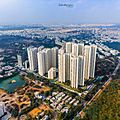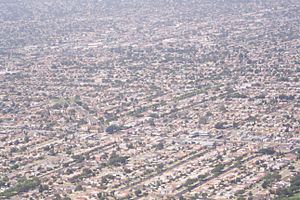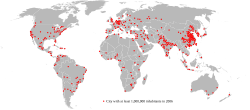Megacity facts for kids
A megacity is a super big city, usually home to more than 10 million people! Imagine a city so huge, it's like a whole country packed into one place. The United Nations Department of Economic and Social Affairs says a megacity is an urban agglomeration (which means a main city and its surrounding built-up areas) with over 10 million residents. Other groups might say the number is a bit lower, like 5 to 8 million, but the main idea is a really, really big city.
The exact number of megacities around the world changes depending on who is counting. In 2018, the UN said there were 33. By 2023, other sources like CityPopulation.de counted 45, and Demographia counted 44. About half of these giant cities are in China and India. Other countries with more than one megacity include Brazil, Japan, Pakistan, and the United States. You can find megacities in Africa (like in Nigeria and Egypt), Europe (like in Russia and the United Kingdom), and Latin America (like in Mexico and Argentina). Some people think Tokyo in Japan is the biggest megacity, while others say it's the Pearl River Delta in China.
Contents
List of Megacities Around the World
Here's a list of some of the world's megacities and how many people live in them, according to different reports:
| Megacity | Image | Country | Region | Estimated population | ||
|---|---|---|---|---|---|---|
| CityPopulation.de 2023 |
Demographia 2023 |
UN DESA 2018 |
||||
| Bangalore |  |
South Asia | 13,700,000 | 15,257,000 | 11,440,000 | |
| Bangkok |  |
Southeast Asia | 20,500,000 | 18,884,000 | 10,156,000 | |
| Beijing |  |
East Asia | 20,900,000 | 18,883,000 | 19,618,000 | |
| Bogotá |  |
South America | 10,200,000 | 10,252,000 | 10,574,000 | |
| Buenos Aires |  |
South America | 16,700,000 | 15,748,000 | 14,967,000 | |
| Cairo | North Africa | 22,200,000 | 22,679,000 | 20,076,000 | ||
| Changsha | East Asia | 10,500,000 | 5,065,000 | 4,345,000 | ||
| Chengdu |  |
East Asia | 16,600,000 | 15,016,000 | 8,813,000 | |
| Chennai |  |
South Asia | 12,200,000 | 11,570,000 | 10,456,000 | |
| Chongqing |  |
East Asia | 10,500,000 | 12,653,000 | 14,838,000 | |
| Delhi | South Asia | 33,400,000 | 31,190,000 | 28,514,000 | ||
| Dhaka |  |
South Asia | 21,300,000 | 19,134,000 | 19,578,000 | |
| Dongguan |  |
East Asia | Combined with Guangzhou |
10,753,000 | 7,360,000 | |
| Guangzhou |  |
East Asia | 67,800,000 | 27,119,000 | 12,638,000 | |
| Hangzhou |  |
East Asia | 13,400,000 | 9,618,000 | 7,236,000 | |
| Ho Chi Minh City |  |
Southeast Asia | 13,500,000 | 14,953,000 | 8,145,000 | |
| Hyderabad |  |
South Asia | 11,100,000 | 9,797,000 | 9,482,000 | |
| Istanbul |  |
Europe, West Asia | 16,100,000 | 14,441,000 | 14,751,000 | |
| Jakarta |  |
Southeast Asia | 28,900,000 | 35,386,000 | 10,517,000 | |
| Johannesburg |  |
Southern Africa | 14,800,000 | 15,551,000 | 5,486,000 | |
| Karachi | South Asia | 19,100,000 | 20,249,000 | 15,400,000 | ||
| Kinshasa |  |
Central Africa | 15,000,000 | 13,493,000 | 13,171,000 | |
| Kolkata |  |
South Asia | 17,400,000 | 21,747,000 | 14,681,000 | |
| Lagos |  |
West Africa | 21,400,000 | 14,540,000 | 13,463,000 | |
| Lahore |  |
South Asia | 14,400,000 | 13,504,000 | 11,738,000 | |
| Lima |  |
South America | 11,600,000 | 10,556,000 | 10,391,000 | |
| London |  |
Europe | 14,800,000 | 10,803,000 | 9,046,000 | |
| Los Angeles |  |
North America | 17,700,000 | 15,587,000 | 12,458,000 | |
| Luanda |  |
Central Africa | 9,000,000 | 10,914,000 | 7,774,000 | |
| Metro Manila |  |
Southeast Asia | 26,700,000 | 24,156,000 | 13,482,000 | |
| Mexico City |  |
North America | 24,900,000 | 21,905,000 | 21,581,000 | |
| Moscow |  |
Europe | 18,800,000 | 17,878,000 | 12,410,000 | |
| Mumbai |  |
South Asia | 26,600,000 | 25,189,000 | 19,980,000 | |
| Nagoya |  |
East Asia | 10,500,000 | 9,439,000 | 9,507,000 | |
| New York City |  |
North America | 23,100,000 | 21,396,000 | 18,819,000 | |
| Osaka |  |
East Asia | 17,700,000 | 14,916,000 | 19,281,000 | |
| Paris |  |
Europe | 11,400,000 | 11,108,000 | 10,901,000 | |
| Rio de Janeiro |  |
South America | 13,400,000 | 12,306,000 | 13,293,000 | |
| São Paulo |  |
South America | 23,000,000 | 21,486,000 | 21,650,000 | |
| Seoul |  |
East Asia | 24,900,000 | 23,225,000 | 9,963,000 | |
| Shanghai |  |
East Asia | 40,000,000 | 24,042,000 | 25,582,000 | |
| Shenzhen |  |
East Asia | Combined with Guangzhou |
17,778,000 | 11,908,000 | |
| Tehran |  |
West Asia | 16,200,000 | 13,382,000 | 8,896,000 | |
| Tianjin |  |
East Asia | 11,400,000 | 10,047,000 | 13,215,000 | |
| Tokyo |  |
East Asia | 40,800,000 | 37,785,000 | 37,468,000 | |
| Wuhan |  |
East Asia | 11,800,000 | 10,353,000 | 8,176,000 | |
| Xiamen |  |
East Asia | 14,500,000 | 5,253,000 | 3,585,000 | |
| Xi'an |  |
East Asia | 12,300,000 | 12,211,000 | 7,444,000 | |
| Zhengzhou |  |
East Asia | 9,450,000 | 11,068,000 | 4,940,000 | |
How Megacities Grew Over Time
The word "megacity" started being used around the early 1900s. The United Nations first used it for cities with 8 million people or more, but now it means cities with over 10 million.
Back in 1800, only 3% of the world's people lived in cities. By the year 2000, this number jumped to 47%! In 1950, there were only 83 cities with over a million people. By 2007, that number grew to 468. Experts think that by 2030, nearly 5 billion people will live in cities. That's three out of every five people!
Most of this growth is happening in developing countries, especially in Asia and Africa. Sadly, many people moving to cities end up living in shanty towns or slums. These areas often don't have good housing, clean water, or proper healthcare. By 2030, over 2 billion people might live in slums.
Historical City Sizes
For about 500 years, Rome was the biggest and most important city in Europe. Its population reached over a million people by the end of the 1st century BC. Later, its population dropped a lot.
Other ancient cities also grew very large. Baghdad was likely the biggest city in the world from around 762 AD to the 930s, with over a million people. Chinese capital cities like Chang'an and Kaifeng also had huge populations during their golden ages. The area around Angkor in Southeast Asia, a capital city from the 9th to 15th centuries, might have had up to a million people too.
From about 1825 to 1918, London was the world's largest city. It was the first city to reach over 5 million people in 1900. In 1950, New York City was the only urban area with more than 10 million people. But by 2005, there were 25 such megacities! This shows how quickly cities are growing as more people move from rural areas to urban ones.
Since the 2000s, the Greater Tokyo Area has been the largest megacity. This area includes cities like Yokohama and Kawasaki. Its population is estimated to be between 37 and 38 million people. It can be tricky to count the exact population of a megacity because it's hard to define where the city ends and the surrounding areas begin.
Challenges of Living in a Megacity
Living in a megacity can be exciting, but it also comes with big challenges.
Slums and Informal Settlements
Even though the percentage of people living in slums has gone down, the actual number of people living in them is still growing because cities are getting so much bigger. These informal settlements often lack good housing, clean water, proper sewers, and even official addresses. This happens because so many people move to cities, and there isn't enough affordable housing for everyone. People in slums often struggle to get an education, healthcare, or good jobs.
Homelessness in Big Cities
Megacities often have many people who are homeless. The definition of homelessness can be different in various places. In the United States, research in 2002 showed that children and families were the fastest-growing group of homeless people. This creates new problems for organizations trying to help.
Some cities are trying a "Housing first" approach. This means instead of keeping homeless people in shelters, they try to get them into permanent homes quickly. Then, they offer support to help them stay in their new homes. This can be a complicated process, but it aims to solve homelessness more effectively.
Traffic Jams

Traffic congestion is a big problem in megacities. It happens when too many cars are on the roads. This leads to slower speeds, longer travel times, more pollution, and cars waiting in long lines. In 2000, traffic jams in the biggest US cities caused billions of hours of delays and wasted billions of gallons of fuel. It also cost a lot of money due to lost work time. Traffic is getting worse in big cities and even in smaller towns.
Urban Sprawl

Urban sprawl means that a city and its suburbs spread out into the countryside. This often leads to low-density areas where people need cars to get around. Some people think sprawl is bad because it means longer drives to work, more reliance on cars, and higher costs for things like roads and water pipes. It can also mean that different parts of the city are very far apart, making it harder to get to schools, hospitals, or shops without a car.
Gentrification and Neighborhood Change
Gentrification happens when wealthier people start buying homes in neighborhoods that were less wealthy. As more expensive homes and businesses move in, the cost of living goes up. This can make it hard for people with lower incomes who have lived there for a long time to afford to stay. They might be forced to move out, changing the neighborhood's character and the people who live there.
Air Pollution in Cities
Air pollution is when harmful chemicals or tiny particles get into the air. This can hurt people, animals, or the environment. Many megacities have big problems with smog. Smog is a type of air pollution mostly caused by car exhaust and factory fumes. These fumes react with sunlight to create a hazy, unhealthy air mixture.
Managing Resources
Megacities are so large and complex that they face huge challenges in managing their resources. This includes how they get and use electricity, heating, fuel, water, and how they deal with waste. Making megacities sustainable means finding smart ways to use these resources efficiently and reduce waste.
Megacities in Stories and Movies
Megacities are often featured in dystopian science fiction stories. These are stories about a future world where things have gone wrong. For example:
- In William Gibson's book Neuromancer, there's a huge megacity called the Sprawl.
- In the Judge Dredd comic, there's Mega-City One, a giant city with hundreds of millions of people along the east coast of the United States.
- The movie Demolition Man shows a megacity called "San Angeles". It was formed when Los Angeles, Santa Barbara, and San Diego joined together after a big earthquake.
- In the Star Wars universe, there's a planet-wide city called Coruscant with a population of 2 trillion!
- Trantor in Isaac Asimov's Foundation books is another example of a planet that is entirely one giant city.
See also
 In Spanish: Megaciudad para niños
In Spanish: Megaciudad para niños
- Economies of agglomeration
- Global city
- List of largest cities
- List of largest cities throughout history
- Megalopolis
- Urban sprawl


